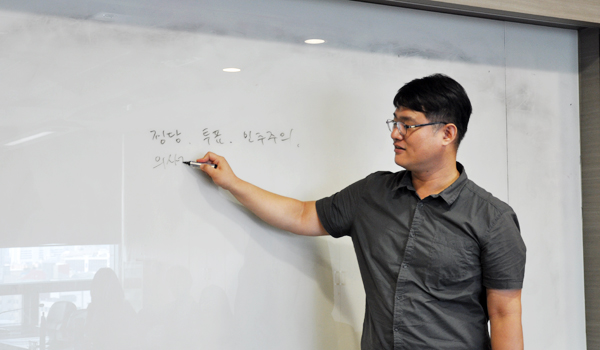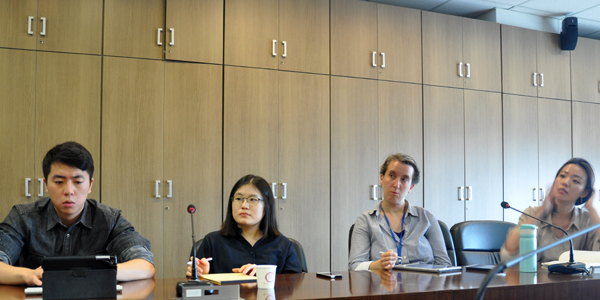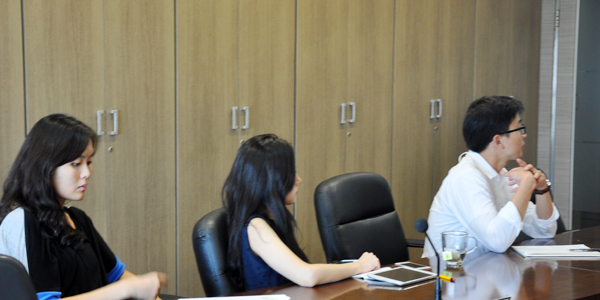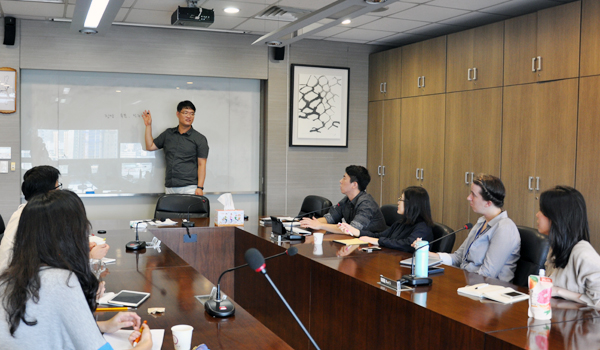EAI는 인턴들이 본 인턴 세미나를 통해 좀 더 능동적이고 자율적인 모습으로 연구원 활동에 참여하고 학교 내에서 접할 수 없는 새로운 지식을 습득할 수 있게 되기를 기대합니다. 또한, 내부 커뮤니케이션의 증대, 네트워크 활성화 그리고 배움의 기회를 제공함으로써 연구원과 인턴들간의 장기적 관계 발전 형성에 기여하고자 합니다.
발표자
신영환 EAI 외교안보연구팀 팀장
참석자
노가연, University of Chicago
박 건, 서울대학교
박규현, 연세대학교 국제대학원
안지혜, 동국대학교
이예원, 연세대학교 국제대학원
우희랑, 고려대학교 국제대학원
최보경, 고려대학교 국제대학원
Elizabeth Burris, Georgetown University




| 내용정리 |
작성자
박규현, 외교안보연구팀 인턴 (연세대학교 국제대학원)
I. Introduction to Political Science
Evolution of “Politics”
Aristotle said human beings are by nature political animals. Max Webber further added to this claim by stating that man is by nature a social animal. The introduction of the idea “society” was in Greece where they came up with the term, “polis”— a tight knit small community of Ancient Greek citizens who agreed on certain rules and customs. It was conceived on the notion that human beings cannot live by themselves and that happiness could only be achieved through a community. When asked what ideas they came up with when imagining modern-day politics the interns shared the following things: parties, voting, democracy, decision, government, citizen, authority, dictatorship, etc.
The Importance of Decision-Making
In today’s society where people with different values exist and an entrenched system of hierarchy, authority, and the people abiding by the set rules coexist; decision-making serves the function of making policy—a tool to make a better society.
Thirdly, the process of allocating social values was talked about. Allocation of social values: authority (where people have gathered together), social values (money, health, survival, authority, etc), distribution (related to economics), and process.
Difference between Power and Authority
Power usually has an exerciser and a recipient, i.e. it is a unilateral relationship. On the other hand, authority is where power is given to a leader voluntarily by the recipients.
Structural Power (a.k.a. “Structuralism”)
There is a need for understanding the social structure first, only then can people fully understand the individuals and society.
In an international relations perspective, power structure can be rendered through territory. Depending on where the state is geographically located, it could assume a lot of power—or not. At the same time power is not always represented through hard power but could also be demonstrated through soft power—for instance through a country’s cultural attraction.
II. International Relations
“Hegemony”
The term “hegemony” was coined by the leftist Italian theoretician and politician, Antonio Gramsci. Gramsci came up with the term while observing Italy’s transition to Fascism. Social revolution is not easy. Even after a revolution occurs most people will still have trouble accepting the new structure. Once the incumbent party succeeds in making people accept their core beliefs and ideology, however, this becomes hegemony. The US is a hegemony because it has rendered other nations to follow its system, e.g. capitalism, democracy, etc.
*Do not confuse authority with hegemony though. For instance, the fraudulent election orchestrated by Syngman Rhee resulted in the April 19 Revolution.
Does International Society Reflect a Polis?
Not really, because there is no single governing body in the world arena. Only in the UN do nations get an equal number of votes. Although Hobbes speaks of an anarchic society, there's still order in today’s world. This order isn’t maintained by a single government but states still somehow abide by the rules, thus the concept of global governance, regime, etc.
Traditional Security
The “state” was created in order to protect an individual's survival and safety in a world where any state could invade another state. The consequences of invasion are plunder, deaths, etc and national security comes in to protect a state from these atrocities.
Until the end of the Cold War the main security concern was the threat of invasion from a foreign country. Once the War ended, however, the concept of “human security” came into the fore.
III. “Blood Diamond” and Human Security
Human security is an umbrella concept that not only includes the threat from a state but also other factors such as diseases (e.g. MERS and SARS in South Korea), inequality, economic poverty, global warming, food crisis, etc. It was a term coined by UNDP in 1994 and signaled a transition from a traditional security dynamic to a non-traditional one in the 21st century. For instance, if there is a flooding in Bangladesh—where the national economy is hugely dependent on agriculture, its people will be hugely impacted.
The issues highlighted in the movie “Blood Diamond” (e.g. mass genocide, refugee crisis, child soldiers, rape, food shortage, mutilation, etc) all intricately relate to problems of human security. In Sierra Leone where there had been no legitimate government, selling diamonds was a bargaining chip to buying weapons and attaining power.
IV. Q&A
Q1: Sir, is infrastructure an absolute prerequisite for utilizing resources?
A: Physical support is important too but more crucially there needs to be civic consciousnes. South Korea was able to transform into a democracy so swiftly as a result of strong civic consciousness.
Q2: Sir, you mentioned that humans don't change easily. So how can we change civic consciousness for the betterment of society?
A: It is true that people infrequently change but society has different types of people. For instance let us take a look at the case of Myanmar. The majority of the people in Myanmar have no idea about democracy but there are still the elite who have authority and want to spur change in society. And it is because of the guidance of these people that the civic consciousness is changing for the best of people.
Q3: There is a lot of inefficiency and corruption when it comes to utilizing the ODA funds by the recipient countries. What practical tools or buffers exist to mitigate this problem?
A: In order to tackle this issue in the past, there were initiatives such as the Roma Treaty that attempted to promote efficiency and transparency of the ODA funds.